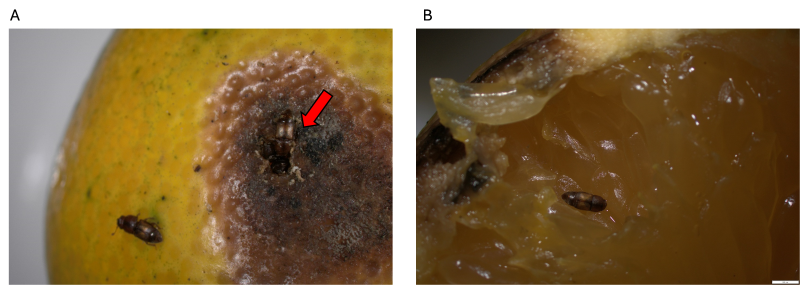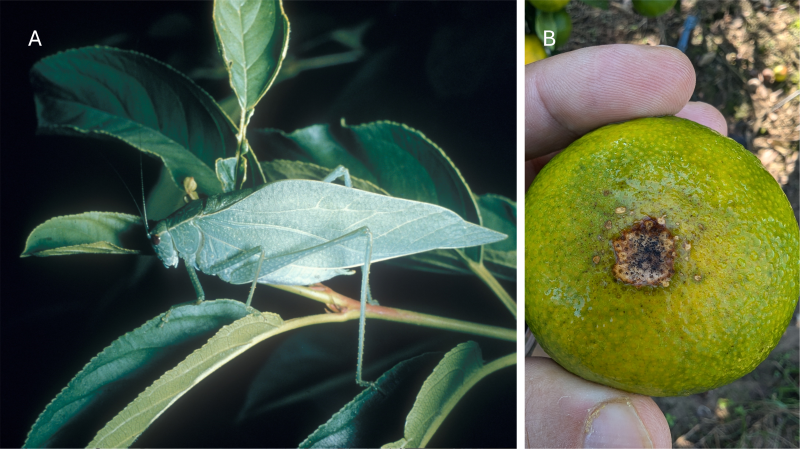Xavier Martini, & Derrick Conover, North Florida Research and Education Center, Danielle Williams, UF/IFAS Extension Gadsden County, and Lauren Diepenbrock, Citrus Research and Education Center
Sap Beetles
We received several calls from growers last week concerned that some of their fruits had been attacked by small beetles. All the suspected fruits had small holes, and when the fruit was opened many adults and larvae were found (Figure 1). Sometimes, they were accompanied by small vinegar flies. These beetles have been identified as cornsap beetles (Carpophilus dimidiatus, Nitidulidae family). Sap beetles are attracted to sweet, overripe, or decomposing fruits and vegetables, making them common on farms, particularly on damaged/dropped fruit. In the present case, all the sap beetles were found on fruits that already had damage.

Figure 1: (A) Sap beetle emerging from a boring hole (red arrow) dug into a damaged fruit. (B) Sap beetle found within the damaged fruit Credit: Derrick Conover, UF/IFAS
–
Katydids
For instance, at one of our grower fields, we found a lot of these beetles boring holes in damage scars made by katydids. Katydids are orthopterans (same order than grasshoppers or locusts) in the Tettigoniidae Family. When they feed on fruits, they remove the top layers of the peel allowing entrance of pathogens such as fungi. The injury due to katydid feeding, and the fungi growing on the damage soften the peel making it a good point of entry for the beetles (Fig. 2).

Figure 2: (A) broad-winged katydid (Microcentum rhombifolium) and (B) damage on a satsuma fruit. Credit: Lyle Buss and Xavier Martini, UF/IFAS
–
We conducted a short experiment in our lab, where sap beetles were isolated with satsuma fruits with no damage, or isolated with fruits with katydid damage. We found that the sap beetles were only able to enter the damaged fruits, whereas undamaged fruits remained intact. It is important to highlight that in the context of satsuma and cold hardy citrus in general, the fruits are for the fresh market only, which means that any fruit with katydid (or any damage on the fruit peel) is already lost for harvest when the sap beetles arrive.
–
Take Home Message
In summary, while sap beetles can be considered a pest in some crops (such as strawberries and corn) this is not the case for citrus, and their presence should not warrant any treatment. However, katydids should be monitored to prevent infestations in citrus groves, even if most of the time they are considered sporadic pests and rarely require chemical control. Like many orthopterans, katydids are generalist herbivores and do not specifically target citrus. They tend to feed on weeds surrounding the grove and migrate onto citrus occasionally. Therefore, the first action would be to properly control weeds around the citrus grove to reduce alternative hosts for this pest (for instance by mowing the weeds growing in the row middles). Adjacent pastures, hay fields, and fallow lands can be significant sources of orthopterans pests, and therefore it is recommended to avoid growing them in proximity to the citrus grove. If katydids and orthopteran pests in general are not kept at low density by weed control, a chemical treatment can be applied. Carbaryl-based insecticides (carbamate family) have demonstrated efficacy against these pests, but their broad range can eliminate beneficial insects and trigger spider mites. An alternative to carbaryl are diamides such as chlorantraniliprole that can suppress katydid nymphs and are labeled for citrus. Diamides have the advantage of also being efficient against citrus leafminer and therefore can be used to control both pests.
–
More information:
Sap beetles of Florida – Nitidulidae
2024–2025 Florida Citrus Production Guide: Plant Bugs, Chewing Insect Pests, Caribbean Fruit Fly, and Thrips
- Pepper Weevil is a True Menace to Pepper Production - October 3, 2025
- Sap Beetles are Not a Cause of Concern for Citrus but Katydids Are - October 4, 2024
- The Importance of Pollination for Seedless Watermelons and How to Enhance it - April 5, 2024
